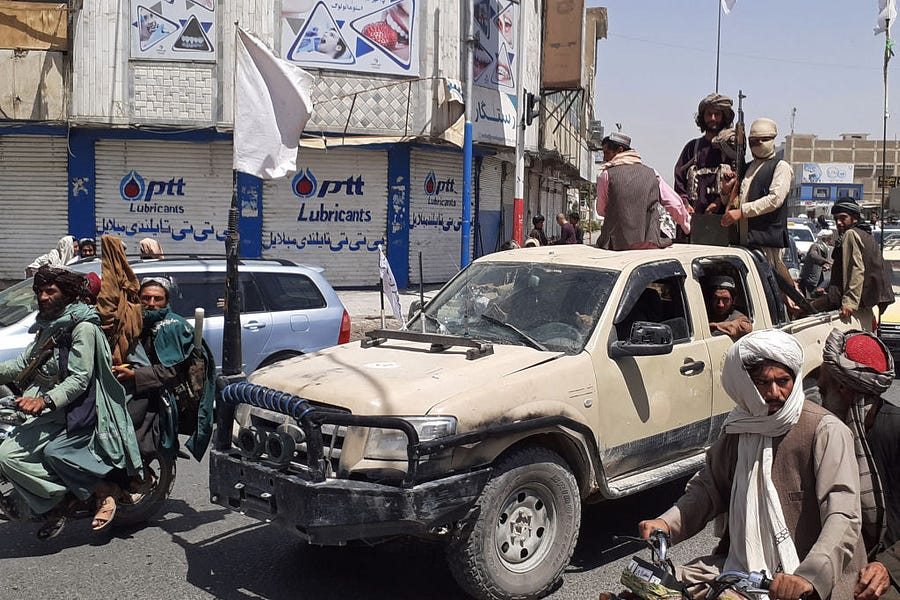On July 8, President Joe Biden thought it was necessary to defend his decision to withdraw from Afghanistan once again. The president had announced America’s retreat from its longest war less than three months earlier.
Whether President Biden knew or not, the Afghan government was teetering as he spoke in mid-July. He placed the onus squarely on the shoulders of Afghanistan’s security forces.
“Together, with our NATO Allies and partners, we have trained and equipped … nearly 300,000 current serving members of the military—of the Afghan National Security Force, and many beyond that who are no longer serving,” President Biden said. “Add to that, hundreds of thousands more Afghan National Defense and Security Forces [ANDSF] trained over the last two decades.”
The president went all-in on the ANDSF, arguing that America’s partners had the capacity and capability to defend their country, which America was leaving behind. “We provided our Afghan partners with all the tools—let me emphasize: all the tools, training, and equipment of any modern military,” the president elaborated. “We provided advanced weaponry. And we’re going to continue to provide funding and equipment. And we’ll ensure they have the capacity to maintain their air force.”
A reporter asked: “Is a Taliban takeover of Afghanistan now inevitable?”
President Biden pressed his case, saying the Afghans have “300,000 well-equipped” troops, who are “as well-equipped as any army in the world,” with an air force the Taliban lacked. And they were going up “against something like 75,000 Taliban.”
“It is not inevitable,” the president said.
On paper, President Biden may have appeared correct. The Afghans should have enjoyed a numerical and technical advantage. That was the analysis Gen. Mark Milley, the chairman of the Joint Chiefs of Staff, gave Biden. Later in July, even as the insurgency was racking up wins, Milley claimed that the Afghans “have the capacity to sufficiently fight and defend their country.”
The U.S. military has repeatedly reported—again, on paper—that there are hundreds of thousands of Afghans ready to defend their country. While U.S. generals have expressed reservations at times, they’ve also portrayed the ANDSF as a much more capable force—one that certainly wouldn’t be routed within just a few short months.
It was all a mirage. Wars aren’t fought on paper.
The Taliban and al-Qaeda unleashed an unprecedented campaign in the weeks that followed Biden’s July 8 remarks, and have since overrun much of the country. In the past week alone, the jihadists have seized 16 Afghan provincial capitals. More will fall in short order.
As should be obvious by now, the Afghans did not have “300,000 well-equipped troops” ready to counter the jihadists’ offensive. Nor did the Taliban have just 75,000 men. As the jihadists threaten to take over much of the country, it is obvious that Biden and Milley grossly miscalculated. The paper estimates offered by the U.S. military’s leadership, as well as some former military analysts, were worthless. They had no idea what they were talking about.
In these dark hours, as the jihadists maraud across Afghanistan, we should remember that tens of thousands of Afghans fought and died in an attempt to save their country from totalitarian sharia rule. There are many who dismiss their sacrifice. We shouldn’t. Still, it is crystal clear that the Afghan forces were not ready to defend their country.
There were plenty of warning signs. According to the special inspector general for Afghanistan reconstruction (SIGAR), an oversight body that reports to Congress, the U.S. has disbursed more than $75 billion to Afghan security forces. This should have been enough to pay for a more competent fighting force.
But SIGAR has documented the ANDSF’s many problems. Corruption, attrition, poor management and the issue of “ghost soldiers”—or troops who were on the payroll, but didn’t really exist—have plagued the ANDSF. Reading through SIGAR’s reporting these past several years, it was clear that the ANDSF was not ready to take the lead—as Biden and Milley claimed. SIGAR said as much, warning that “Afghan security forces are not yet capable of securing their own nation.”
The Afghan political leadership in Kabul deserves blame, too. America’s withdrawal from Afghanistan has been as poorly managed as possible. Across administrations, the U.S. wasted much time in servile diplomacy with the Taliban, which undermined Kabul’s legitimacy and puffed up the jihadists’ cause. But at some point, the Afghans needed to be better prepared to defend themselves—at least better than what we’ve witnessed in recent months. The Taliban and al-Qaeda are fighting for the resurrection of the Islamic Emirate of Afghanistan. The Afghan government has never had such a unified purpose.
Which brings us to one of the other major failures here: The U.S. and Afghan governments apparently did not see the jihadists’ offensive coming.
The Defense and State Departments were heavily invested in the idea that a negotiated political settlement was not only possible, but also the only path forward. This was rubbish. While American officials were prattling on about how there is “no military solution” for the war, the Taliban and al-Qaeda were planning their conquest -their own military solution.
My colleague, Bill Roggio, has described it as the biggest military-intelligence failure since the Tet offensive in 1968. It is that, but as Bill would agree, it was also just a failure of common sense.
America never understood who it was fighting in Afghanistan. To this day, the U.S. military cannot even accurately describe the relationship between the Taliban and al-Qaeda, an issue I’ve written about at great length. The military would have us believe there is nothing “strategic” about their unbroken alliance. Meanwhile, consider just some basic facts: The head of al-Qaeda, Ayman al-Zawahiri, has sworn a blood oath of allegiance to the Taliban’s “Emir of the Faithful,” Haibatullah Akhundzada. That oath is unbroken. Akhundzada’s top deputy is Sirajuddin Haqqani. Siraj is an al-Qaeda man. And as we’ve repeatedly documented at FDD’s Long War Journal, al-Qaeda doesn’t have just a few hundred fighters, as the U.S. intelligence community and military claim. Al-Qaeda and its various arms are fighting throughout the country.
President Biden claimed last month that “the likelihood there’s going to be the Taliban overrunning everything and owning the whole country is highly unlikely.”
He was wrong—not just about the Taliban’s chances of total victory in the original 9/11 war, but also al-Qaeda’s.






Please note that we at The Dispatch hold ourselves, our work, and our commenters to a higher standard than other places on the internet. We welcome comments that foster genuine debate or discussion—including comments critical of us or our work—but responses that include ad hominem attacks on fellow Dispatch members or are intended to stoke fear and anger may be moderated.
With your membership, you only have the ability to comment on The Morning Dispatch articles. Consider upgrading to join the conversation everywhere.